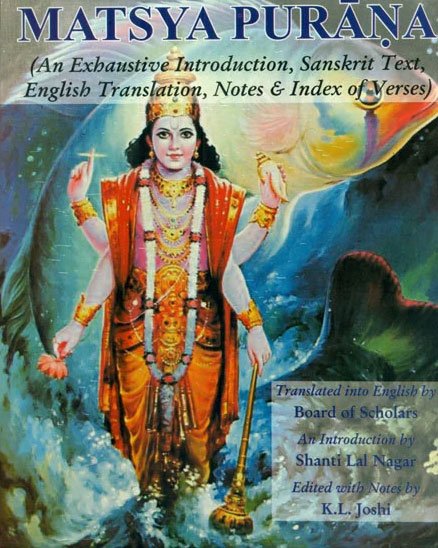The Matsya Purana (critical study)
by Kushal Kalita | 2018 | 74,766 words | ISBN-13: 9788171103058
This page relates ‘Shaivism: The Shiva-cult’ of the English study on the Matsya-purana: a Sanskrit text preserving ancient Indian traditions and legends written in over 14,000 metrical verses. In this study, the background and content of the Matsyapurana is outlined against the cultural history of ancient India in terms of religion, politics, geography and architectural aspects. It shows how the encyclopedic character causes the text to deal with almost all the aspects of human civilization.
Part 2 - Śaivism: The Śiva-cult
Śaivism regards Śiva as the Highest or Supreme Reality. It is one of the oldest sects of Hinduism. Devotion to Śiva or His different forms and symbols is the main feature of Śaivism. The roots of Śiva worship go back to the pre-Vedic period. However, the present god Śiva is said to have developed out of the Vedic god Rudra. Though the name Śiva is not found in the Vedas, the word śiva occurs as a epithets of Rudra in many places. Ṛgveda, Yajurveda, Sāmaveda, Atharvaveda and Brāhmaṇas have given more importance to Lord Śiva. There are many points in the Ṛgveda to establish it that Rudra of the Ṛgveda is the Śiva of later periods. In Śatarudriya hymn, which exists in both the Taittirīyasaṃhitā and the Vājasaneyīsaṃhitā the character of Rudra as Śiva has fully emerged.[1]
In the Gopathabrāhmaṇa, Rūdra is replaced by Śiva. In the Vājasaneyisaṃhitā and Tattirīyasaṃhitā the one hundred (100) names of Lord Śiva is found.[2] The Atharvaveda also bears description of the glory of Rudra.[3] In the Śvetāśvataropaniṣad, Śiva is raised to the highest position as Parabrahman. Glorification of Śiva or Rudra or Paśupati is made at its highest level during the period of the Epics and Purāṇas. Śaivism had become one of the principal religions in the epic and Purāṇic age. During the period of Purāṇas devotees worshipped him for all kinds of boons and gifts. In the Rāmāyaṇa, when Rāma had to go to Laṅkā to rescue his beloved wife Sītā from the captivity of Rāvaṇa, he worshipped Śiva in the liṅga form on the coast of the sea. Rāvaṇa himself also was a great devotee of Śiva and always carried with him a golden liṅga for his worship. Śiva acquired high position during the times of the Mahābhārata. Śiva is praised as the unborn creator of the universe and the unchangeable.[4] In the Purāṇas especially in the Śaiva Purāṇas, Śiva is worshipped as Parabrahman. According to the Vāyupurāṇa, he is the creator, sustainer and annihilator.[5] He creates the seven great sages, gods and other human beings along with all creatures. [6]
The Matsyapurāṇa derives the word rudra from the roots √rud and √dru which mean ‘to weep’ and ‘to run’ respectively pointing out the two characteristics, viz., weeping and running (rodanād dravaṇāccaiva).[7] It has also mentioned that the Rudras were born from Brahmā and their mother was Surabhi. As soon as they were born they started to run here and there and started to cry rebuking Brahmā. That is why, they were called Rudras. However the Matsyapurāṇa has given two different versions of these Rudras. In one place it has mentioned that Rudras were born of Brahmā while in another place it is said that Rudras were the sons of Kāśyapa.[8] But in both the places Surabhi is regarded as their mother. The names of the eleven (11) Rudras are also differently mentioned.
In the fifth chapter, Matsyapurāṇa has given the names of eleven Rudras as:
- Ajaikapāda,
- Ahirbudhnya,
- Virūpākṣa,
- Raivata,
- Hara,
- Bahurūpa,
- Tryambaka,
- [Sureśvara,]?
- Sāvitra,
- Jayanta,
- Pinākī and
- Aparājita.[9]
On the other hand, the names of eleven Rudras born of Brahmā are mentioned as:
- Nirṛti,
- Śambhu,
- Aparājita,
- Mṛgavyādha,
- Kāpardī,
- Dahana,
- Khara,
- Ahirbudhna,
- Kāpālī,
- Piṅgala and
- Senānī.[10]
Again, in 153rd chapter, the eleven Rudras are mentioned as
Footnotes and references:
[1]:
Tattirīyasaṃhitā, IV. 5.1; Vājasaneyasaṃhitā,16.4
[3]:
Atharvaveda, 11.1.5; also cf., 6.2.5; 6.4.2; 6.7.3 etc.
[4]:
Mahābhārarata, 7.80,81
[5]:
[6]:
Ibid. 3.1; 24.83-100; 32.4-5; 55.37; 7.78 etc.
[7]:
Matsyapurāṇa,171.38
[8]:
Ibid., 5.31; 6.44
[9]:
Ibid., 5.29-30
[10]:
, 171.38-39
[11]:
Ibid., 153.19
